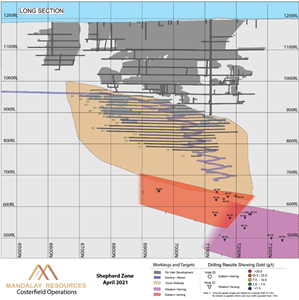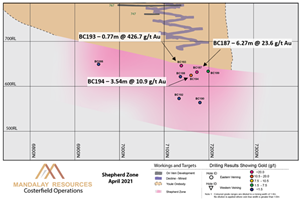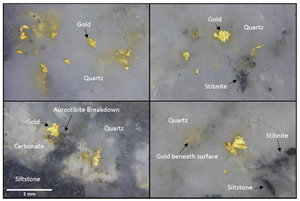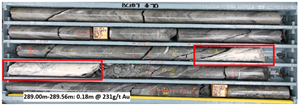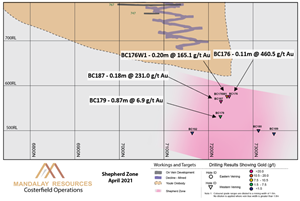Mandalay Resources Corporation Discovers New Gold Rich Structural Domain Below the Youle Mine
TORONTO, April 26, 2021 (GLOBE NEWSWIRE) -- Mandalay Resources Corporation ("Mandalay" or the "Company") (TSX: MND, OTCQB: MNDJF) is pleased to provide preliminary details on the newly-discovered structural domain below the Youle deposit named the Shepherd Zone at its Costerfield Operation (Victoria, Australia), containing coarse visible gold in two major veining horizons.
Drilling highlights:
Eastern Veining
- 23.6 g/t gold over true width of 6.27 m in BC187; and
- 426.7 g/t gold over a true width of 0.77 m in BC193
Western Veining
- 231.0 g/t gold over a true width of 0.18 m in BC187; and
- 460.5 g/t gold over a true width of 0.11 m in BC176 (previously reported)
Note: Further intercept details including a breakdown of the aggregated 6.27m intercept in BC187 can be found in Table 1 in the Appendix to this document.
Dominic Duffy, President and CEO of Mandalay, commented: “Follow-up drilling on the recently released Youle depth discovery has yielded extremely exciting results, which verified the grade and continuity of the initial discovery, and also intercepted further significant-grade veining just below the currently planned depth extent of Youle development.”
Mr. Duffy continued, “The orientation of the new veins is east dipping and due to the location of Youle’s access development, this target although anticipated, had not been able to be adequately tested until now from newly developed drilling platforms to the east of Youle.”
Mr. Duffy continued, “This discovery could mark yet another step change for Costerfield, which is already one of the world’s highest-grade producing gold mines with a Proven and Probable Mineral Reserves grade of 12.8 g/t gold and 3.5% antimony. With this discovery, we see that the endowment of gold increases within the diffuse fracture network, and the system continues to grade towards comparable veining at the nearby, word-class Fosterville deposit.”
Mr. Duffy continued, “In light of these results, we are accelerating our underground drilling to expedite our understanding of this veining along strike and at depth. Our mine engineering team has accessed additional underground drilling platforms within the Youle infrastructure, which will allow us to increase the number of underground drill rigs in the coming months.”
Mr Duffy concluded, “Alongside this exploration release, a video has been prepared by Mr. Chris Davis, Vice President of Operational Geology and Exploration, to further explain the information in this release. The video can be found on Mandalay’s website or by clicking here.”
A New Structural Domain – Shepherd Zone
In January 2021, an initial step-out hole intercepted what the Company now refers to as the Western Veining within the Shepherd Zone. This initial intercept in BC176 (0.11 m @ 460.5 g/t gold) was a subvertical to east dipping quartz vein. Follow-up drilling was undertaken, however, due to its orientation the vein could not be properly targeted until another underground drilling platform was developed in March (Figure 1). BC187 was the first hole drilled from this new footwall location and, while it confirmed the targeted Western Vein (0.18m @ 231.0 g/t gold), it also intercepted a parallel swarm of veins proximal and adjacent to the Youle orebody. This new horizon currently consists of 5 major quartz veins, all exhibiting coarse gold with intense sulphide alteration surrounding the veins. The composite grade of this veining is 23.6 g/t gold over a true width of 6.27 m.
The presence and orientation of this veining is an exciting discovery that confirms Mandalay’s targeting strategy, which was updated following completion of the 2019 Costerfield Deeps drilling. This ambitious program completed a 1.7 km drillhole (CD001) that swept underneath the Youle orebody, with the objective of developing a better understanding of the relationship between geological structure and mineralization at depth. Detailed geochemical analysis and mineralogical speciation of this drill hole identified a large hydrothermal zone at a vertical depth of ~900 m (300RL). Structurally this system is interpreted to be the feeder zone to the new discovery and the Youle orebody. This updated interpretation directly led to the new discovery, and with this understanding the Company can infer an additional 300 m depth potential to this find.
Figure 1. Cross section of Youle illustrating the orientation of the newly discovered domain as well as new drill holes and intercept locations is available at https://www.globenewswire.com/NewsRoom/AttachmentNg/72a1badc-21ab-4a9d-a011-d1d3092bff52.
Recent drilling presently covers an area of approximately 10,000 square metres in the Eastern Vein and 20,000 square metres in the Western Vein. Additionally, only one existing hole passes though the target zone approximately 200m south of the BC187 intercept. Although drillhole BC086 accessed the target zone at an acute angle, it successfully intercepted sub-vertical auriferous veining, which provides indications of a significant strike extent.
Figure 2. Longitudinal section of Youle illustrating the location of the new structural domain and recent drill intercepts is available at https://www.globenewswire.com/NewsRoom/AttachmentNg/87698c3d-5040-4268-aa8c-d1a21228b666.
Eastern Vein Array
The eastern vein array is interpreted to extend up to meet the west dipping Youle orebody. Within BC187, sub-vertical veining occurs over 6.27 m ranging from 1 cm to 20 cm in width with gold grades ranging up to 522 g/t gold (Figure 4). BC193 and BC194 were drilled from the hanging wall side of Youle and so it is currently unclear whether they passed through the entire mineralized zone or not. Despite this, BC193 intercepted a more discrete yet higher grade intercept (0.77 m @ 426.7 g/t gold) approximately 40 m to the south and above BC187. Further at depth, BC194 intercepted a wider zone of 3.54 m at 10.9 g/t gold including singular veins grading up to 164 g/t gold. Within BC192 and BC190 veining existed over a width of approximately 3m however they only contained trace amounts of mineralization. The disparity in grade could be due to the presence of a quartzite band which historically appears to attenuate grades where it is intercepted in other Costerfield orebodies.
Figure 3. Longitudinal section with the Eastern Veining of the Shepherd zone in focus is available at https://www.globenewswire.com/NewsRoom/AttachmentNg/4406acb3-6607-442e-8247-d068f5c135fd.
Figure 4. Photograph of 2 veins within the Eastern Vein Array intersected in BC187 highlighting significant individual assays is available at https://www.globenewswire.com/NewsRoom/AttachmentNg/d6028f79-8a98-46a5-98fb-18aa4fcbee9c.
Figure 5. Photomicrograph of gold within the vein at 193.21m of BC187 highlighting the spatial relationship with quartz, carbonate, stibnite and siltstone is available at https://www.globenewswire.com/NewsRoom/AttachmentNg/e71cbc82-a735-4d0f-9a3e-0ad9ec2e61c3.
Western Veining
BC187 also successfully verified the intended target intercepting a 0.18 m wide vein grading 231 g/t gold. This vein correlates with, and is about 30m from, the original intercept in BC176 (0.11 m at 461 g/t gold). This vein was also targeted by BC179 approximately 50 m vertically below BC187, and successfully intercepted multiple veins over a width of 0.87 m at a composited grade of 6.9 g/t gold.
Figure 6. Photograph of BC187 core through the Western Veining is available at https://www.globenewswire.com/NewsRoom/AttachmentNg/a5ce1f18-6f90-4d8a-a61b-416dbf6c798d.
Flat lying laminated quartz structures have also been intercepted though the zone. It has been previously noted within the upper levels of Youle that these laminated quartz veins act as pooling environment for gold and indeed act as the host for the Youle orebody. As yet the nature of the interplay between these structures and the mineralized veining is unclear and the Company continues to investigate their significance.
Figure 7. Longitudinal section with the Western Veining of the Shepherd zone in focus is available at https://www.globenewswire.com/NewsRoom/AttachmentNg/f85c59da-7e29-4a7c-8e1c-c45e005197f7.
Drilling and Assaying
All diamond drill core was logged and sampled by Costerfield geologists. All samples were sent to On Site Laboratory Services (OSLS) in Bendigo, Victoria, Australia, for sample preparation and analysis by fire assay for gold, and Atomic Absorption Spectroscopy (AAS) for antimony. Samples featuring coarse grained visible gold were assayed using a variant of fire assay known as screen fire assay. This method is routinely used to mitigate potential problems associated with heterogeneity in the distribution of coarse gold within drill samples. The procedure collects all coarse heterogenous coarse gold by screening at 75µm after crushing and pulverisation, and subsequently fire assays the resultant mass to extinction. A mass weighted average of gold grade of the sample is subsequently calculated from the +75µm and -75µm fractions of the sample. Site geological and metallurgical personnel have implemented a QA/QC procedure that includes systematic submission of standard reference materials and blanks within batches of drill and face samples submitted for assay. Costerfield specific reference materials produced from Costerfield ore have been prepared and certified by Geostats Pty Ltd., a specialist laboratory quality control consultancy. See Technical Report entitled “Costerfield Operation, Victoria, Australia NI 43-101 Report” dated March 30, 2020, available on SEDAR (www.sedar.com) for a complete description of drilling, sampling, and assaying procedures.
Qualified Person:
Chris Davis, Vice President of Operational Geology and Exploration at Mandalay Resources, is a Chartered Professional of the Australasian Institute of Mining and Metallurgy (MAusIMM CP(Geo)), and a Qualified Person as defined by NI 43-101. He has reviewed and approved the technical and scientific information provided in this release.
For Further Information
Dominic Duffy
President and Chief Executive Officer
Edison Nguyen
Manager, Analytics and Investor Relations
Contact:
647.260.1566
About Mandalay Resources Corporation
Mandalay Resources is a Canadian-based natural resource company with producing assets in Australia and Sweden, and care and maintenance and development projects in Chile. The Company is focused on growing production at its gold and antimony operation in Australia, and gold production from its operation in Sweden to continue being a significant cash flow generating company.
Forward-Looking Statements:
This news release contains "forward-looking statements" within the meaning of applicable securities laws, including statements regarding the exploration and development potential of the Youle deposit (Costerfield). Readers are cautioned not to place undue reliance on forward-looking statements. Actual results and developments may differ materially from those contemplated by these statements depending on, among other things, changes in commodity prices and general market and economic conditions. The factors identified above are not intended to represent a complete list of the factors that could affect Mandalay. A description of additional risks that could result in actual results and developments differing from those contemplated by forward-looking statements in this news release can be found under the heading “Risk Factors” in Mandalay’s annual information form dated March 31, 2021, a copy of which is available under Mandalay’s profile at www.sedar.com. In addition, there can be no assurance that any inferred resources that are discovered as a result of additional drilling will ever be upgraded to proven or probable reserves. Although Mandalay has attempted to identify important factors that could cause actual actions, events or results to differ materially from those described in forward-looking statements, there may be other factors that cause actions, events or results not to be as anticipated, estimated or intended. There can be no assurance that forward-looking statements will prove to be accurate, as actual results and future events could differ materially from those anticipated in such statements. Accordingly, readers should not place undue reliance on forward-looking statements.
Appendix
Table 1. Youle Extensional Drilling Composites
| DRILL HOLE ID | FROM (M) | TO (M) | DRILL WIDTH (M) | TRUE WIDTH (M) | AU GRADE (G/T) | SB GRADE (%) | AU (G/T) OVER MIN. 1.8M MINING WIDTH | VEIN NAME |
| BC086 | 639.73 | 640.44 | 0.71 | 0.21 | 2.4 | LLD | 0.3 | Eastern Veining |
| BC179 | 230.74 | 233.42 | 2.68 | 0.83 | 7.2 | LLD | 3.3 | Western Veining |
| BC179 | 241.09 | 241.51 | 0.42 | 0.14 | 4.8 | LLD | 0.4 | Unnamed |
| BC179 | 247.80 | 248.01 | 0.21 | 0.08 | 6.8 | 0.1 | 0.4 | Unnamed |
| BC180 | 292.48 | 292.88 | 0.4 | 0.17 | 0.0 | 0.1 | 0.1 | Western Veining |
| BC182 | 189.75 | 190.23 | 0.48 | 0.24 | 1.4 | LLD | 0.2 | Unnamed |
| BC187 | 181.00 | 181.11 | 0.11 | 0.09 | 1.1 | LLD | 0.1 | Unnamed |
| BC187 | 184.00 | 184.26 | 0.26 | 0.20 | 2.1 | LLD | 0.2 | Unnamed |
| BC187 | 186.13 | 194.78 | 8.65 | 6.63 | 23.6 | 0.1 | 23.6 | Eastern Veining |
| INCLUDING | 186.13 | 186.26 | 0.13 | 0.10 | 145.0 | LLD | ||
| INCLUDING | 188.77 | 188.87 | 0.10 | 0.08 | 522.0 | LLD | ||
| INCLUDING | 189.21 | 189.37 | 0.16 | 0.12 | 154.0 | LLD | ||
| INCLUDING | 193.21 | 193.39 | 0.18 | 0.14 | 425.0 | LLD | ||
| INCLUDING | 194 | 194.32 | 0.32 | 0.25 | 39.3 | LLD | ||
| INCLUDING | 194.67 | 194.78 | 0.11 | 0.08 | 18.1 | 7.07 | ||
| BC187 | 258.20 | 258.39 | 0.19 | 0.09 | 1.2 | LLD | 0.1 | Unnamed |
| BC187 | 289.00 | 289.56 | 0.56 | 0.18 | 231.0 | LLD | 23.4 | Western Veining |
| BC187 | 291.13 | 291.33 | 0.2 | 0.10 | 1.6 | LLD | 0.1 | Unnamed |
| BC188 | 187.61 | 187.76 | 0.15 | 0.11 | 10.5 | LLD | 0.6 | Eastern Veining |
| BC188 | 294.87 | 295.08 | 0.21 | 0.11 | 1.0 | LLD | 0.1 | Unnamed |
| BC189 | 153.91 | 154.14 | 0.235 | 0.17 | 34.5 | LLD | 3.2 | Eastern Veining |
| BC189W1 | 296.23 | 296.35 | 0.12 | 0.10 | 0.4 | LLD | 0.0 | Unnamed |
| BC189 | 370.07 | 370.36 | 0.29 | 0.09 | 0.0 | LLD | 0.0 | Western Veining |
| BC190 | 201.00 | 212.34 | 11.34 | 4.79 | 0.03 | LLD | 0.0 | Eastern Veining |
| BC192 | 219.00 | 225.45 | 6.45 | 5.28 | 0.02 | LLD | 0.0 | Eastern Veining |
| BC192 | 317.30 | 317.50 | 0.20 | 0.10 | 5.5 | LLD | 0.3 | Western Veining |
| BC193 | 67.64 | 68.84 | 1.2 | 0.77 | 426.7 | LLD | 182.9 | Eastern Veining |
| INCLUDING | 67.81 | 68.21 | 0.40 | 0.26 | 1180.0 | LLD | ||
| INCLUDING | 68.61 | 68.84 | 0.23 | 0.15 | 172.0 | LLD | ||
| BC194 | 76.36 | 84.73 | 8.37 | 3.54 | 10.9 | 0.0 | 10.9 | Eastern Veining |
| INCLUDING | 76.36 | 76.77 | 0.41 | 0.17 | 65.4 | LLD | ||
| INCLUDING | 77.86 | 78.06 | 0.20 | 0.08 | 90.1 | LLD | ||
| INCLUDING | 84.24 | 84.46 | 0.22 | 0.09 | 65.2 | 0.01 | ||
| INCLUDING | 84.61 | 84.73 | 0.12 | 0.05 | 164.0 | 0.02 |
Note: LLD signifies an undetectable amount of antimony. Detection limit for the analysis used is 0.01%


